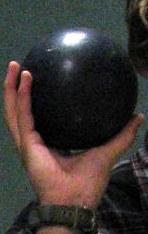Duckpin bowling

Duckpin bowling is a variation of bowling. The balls used in duckpin bowling are significantly smaller than those used in ten-pin bowling, and weigh 1-2 kilograms (2-4lb.) The pins, like the balls, are smaller than their ten-pin equivalents, and it is therefore more difficult to knock them all down with a single roll. The pins are arranged in a triangular fashion identical to that used in ten-pin bowling. Duckpin bowling is commonly found in the New England and Mid-Atlantic regions of the United States.
Rules
Duckpin bowling has rules similar to, but slightly different from, ten-pin bowling. Over the course of ten frames, bowlers try to knock down pins as quickly as possible. Bowlers have three balls per frame, instead of two as in ten-pin bowling, to use in knocking over a set of ten pins. If a bowler knocks down all ten pins with their first throw on a frame, it is scored as a strike. If all the pins are knocked down within the first two throws of a frame, the bowler has made a spare. If all the pins are knocked down by the third ball of the frame, the bowler gets ten points. In the case of a strike, the bowler gets ten points plus the total number of pins knocked down with the next two balls thrown, for a total of up to 30 points. In the case of a spare, the bowler gets 10 points plus the total number of pins knocked down with the next ball, for a total of up to 20 points. A bowlers' final score is the sum of the points they earned in each of the ten frames. The maximum possible score is 300 points, which is achieved by throwing 12 strikes in a row. Professional bowlers typically score around 140-150 points.
History
The origin of the sport is a subject of some debate. According to popular legend, duckpin bowling began in Baltimore, Maryland, around 1900, at a bowling alley owned by future baseball Hall of Famers John McGraw and Wilbert Robinson. However, according to a 2005 baseball book by Howard W. Rosenberg (Cap Anson 3: Muggsy John McGraw and the Tricksters: Baseball's Fun Age of Rule Bending), an article from May 1894 in the Lowell (Mass.) Sun confirms the existence of duckpins as of 1894. Rosenberg traced the story of crediting the origins of duckpins to McGraw and Robinson as far back as Shirley Povich of the Washington Post in the late 1930s. In any event, the name supposedly comes from a remark by McGraw during the first game played with pins cut down from old standard pins. McGraw, an avid duck hunter, said that the flying pins looked like "a flock of flying ducks"; a sportswriter turned the remark into the word "duckpins," and the name stuck.
In 1985, an obscure 130-plus-page publication called Duckpins: The Tenth Frame cited related Lowell, Mass., coverage of duckpin bowling back in May 1894. Writing in that publication, Bob Tkacz, of Newington, Conn., noted finding articles showing that a duckpin tournament was being held in Lowell at that time. The 1985 publication is not readily available from any U.S. library, which explains why Tkacz's finding was easy to miss as the earliest known "in print" rebuttal of the Baltimore origin myth. Articles can be found in the Globe earlier than May 1894 showing the existence of the sport around Boston. According to Rosenberg, the earliest Globe reference to duckpins was apparently on January 2, 1893.
Robinson, by virtue of having been born in Massachusetts, is plausibly the person responsible for introducing the sport to Baltimore; Rosenberg's book methodically accounted for Baltimore newspaper reporting in late 1899 and early 1900, when the sport seemingly was first played in Baltimore (at the McGraw-Robinson alleys,of course). Baltimore Sun next-day reporting seems to credit those alleys for introducing the sport to Baltimore the night before. Consistent with that, unpublished research by Tkacz in the 1980s unearthed the following gem from a 1909 Baltimore publication called Bowlers Guide: "The game of duckpins was first introduced in Baltimore about twelve years ago."
On December 11, 2005, The New York Times, apparently for the first time in its reporting history, pointed to the apparent New England roots of the sport; The Times had previously reflexively recited the canard about the sport having originated in Baltimore. The article, by C. J. Hughes, was titled, "CONNECTICUT AT ITS BEST; Down at Memory Lanes, It's Duckpin Season."
In 1982, the Women's National Duckpin Association was formed to give women a venue to compete in the duckpin sport at a professional level. The organization conducts several tournaments every year in New England and the Mid-Atlantic. The final tournament of each season is called the Grand Prix.[1]
Variants
In the 1930s a variant called Rubberband Duckpin Bowling was made in the Baltimore-Washington area. The pins are circled with hard rubber bands to increase action and scoring. [2] Rubber band duckpin is the only version of duckpin played in Quebec. There have been many perfect games bowled in rubber band duckpin, including the largest duckpin prize ever given out on TV in 1994 $50,000 Cdn.[3] Since it is easier to knock down pins in rubber band duckpin, in this version, the rules of play are identical to those of standard 10 pin bowling.
References
- ^ HOME
- ^ "Duckpin Bowling the Sport of a Lifetime". Hickock's Sports History.Retrieved on Nov. 20, 2006
- ^ "Quilles G plus". 2007-03-21.
External links
- Duckpins.com - Duckpin bowling information and history.
- National Duckpin Bowling Congress
- Womens National Duckpin Association
- Duckpin Professional Bowlers Association
- A June 2008 feature story on duckpin bowling in the Urbanite, a Baltimore weekly magazine
